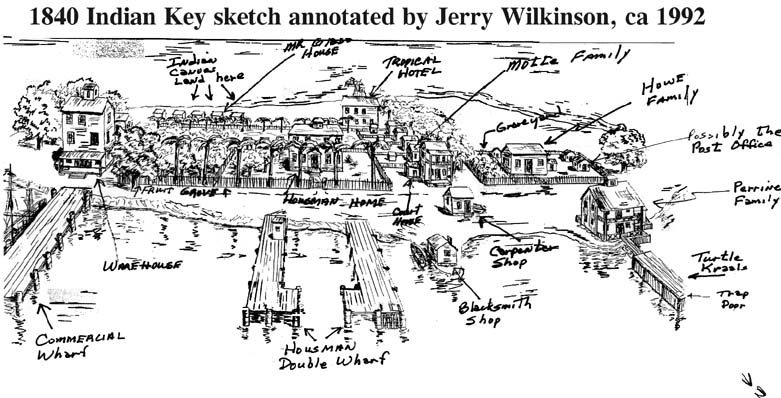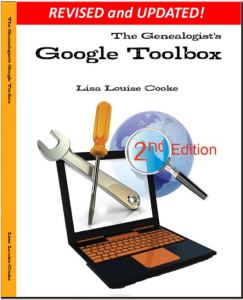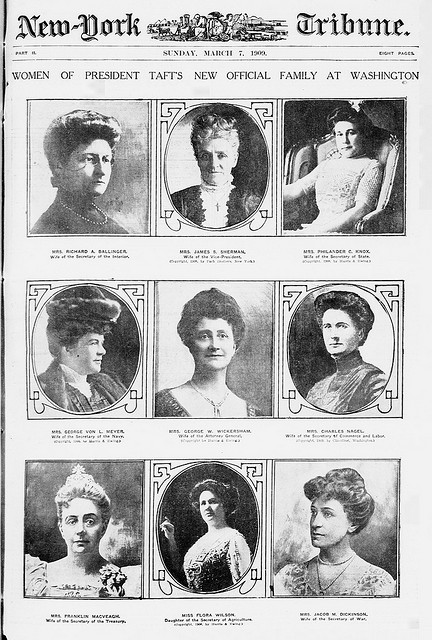by Lisa Cooke | Mar 4, 2015 | 01 What's New, Google, Listeners & Readers, Maps, Records & databases, Research Skills
 Recently I heard from Sue Neale, whose story offers a compelling reason to use Google Scholar for genealogy research! Read it below–then I’ll tell you a little more about Google Scholar.
Recently I heard from Sue Neale, whose story offers a compelling reason to use Google Scholar for genealogy research! Read it below–then I’ll tell you a little more about Google Scholar.
“I’ve been using computers for genealogy research (among other things) for about 30 years and am pretty good at finding most anything on the internet whether it pertains to genealogy or something else. It’s a continuous learning experience because computer, the internet and genealogy on the internet are always changing and updating.
[After hearing your seminars at RootsTech 2015], I tried out a couple of Google searches for my husband’s 3rd great-grandfather Silas Fletcher. Silas lived on Indian Key in the Florida Keys in the early 1820s.
My husband and I and our son visited Indian Key several years ago and the young lady who took us out in the boat had actually written her college thesis on Silas! Of course, we didn’t think to get her name or any other information. So I Googled “scholar paper Silas Fletcher’ and the first item on the search turned out to be her thesis!
I also found a second thesis on Indian Key and a research paper a third person had written–and they both contained information on Silas. In the footnotes I found references to deed books (book number and page number) that contained statements written by Silas, his wife Avis, their daughter Abigail and Mike’s 2nd great grandfather William H. Fletcher about their lives and movements in the Florida Keys.
With that information I went to Familysearch.org and found the deed books I needed for Monroe County. I was able to go find their statements very easily instead of having to ‘browse’ through the books on the off-chance I would find something (which I do if I don’t know the exact book where the record would be).
I can hardly wait to try out the rest of what I learned at your seminars to see what else I can find!”
Sue’s experience is a great example of using Google to dig for your family history. One little-known feature on Google is Google Scholar, which would help Sue and anyone else more easily find material like what she describes: doctoral dissertations, theses, academic papers and more. Your keyword searches in Google Scholar will target results from academic publishers, universities, professional societies and more.

Though scholarly literature gets a bad rap sometimes for being boring or highbrow, they do something genealogists love: THEY CITE SOURCES. Sue cleverly read the footnotes of the materials she found and they led her right to a key source she needed.
Here’s another resource she could find using the details found on Google Scholar in a Google Image search: a map of his community!

My newly-updated, revised book The  Genealogist’s Google Toolbox has an all-new chapter on using Google Scholar. Among other things, I show you advanced search strategies and how to use Google Alerts with Google Scholar for continuous updates on your favorite search results. Click here
Genealogist’s Google Toolbox has an all-new chapter on using Google Scholar. Among other things, I show you advanced search strategies and how to use Google Alerts with Google Scholar for continuous updates on your favorite search results. Click here
by Lisa Cooke | Mar 3, 2015 | 01 What's New, Digital Archives, Memory Lane, Newspaper, United States

Women of President Taft’s New Official Family at Washington, New York Tribune, March 7, 1909. Cover, illustrated supplement. Library of Congress image, posted at Flickr. Click to visit webpage.
The Library of Congress has a Flickr album that’s front page news–literally! It’s a New York Tribune archive with newspaper covers dating back more than a century.
“This set of cover pages from the New York Tribune illustrated supplements begins with the year 1909,” explains the album. “The pages are derived from the Chronicling America newspaper resource at the Library of Congress. To read the small text letters, just click the persistent URL to reach a zoomable version of the page.”
“Daily newspapers began to feature pictorial sections in the late 1800s when they competed for readers by offering more investigative exposés, illustrations, and cartoons. In the 1890s, William Randolph Hearst and Joseph Pulitzer tapped into new photoengraving techniques to publish halftone photographs, and other newspapers soon adopted the practice. The heavily illustrated supplement sections became the most widely read sections of the papers and provided a great opportunity to attract new customers. The daily life, art, entertainment, politics, and world events displayed in their pages captured the imagination of a curious public.”

Available at http://genealogygems.com
We don’t often find our ancestors splashed across front-page news. But we can read over their shoulders, as it were, to see what was going on in their world and what others around them thought about these events. Newspaper articles and ads reveal fashions and fads, prices on everyday items, attitudes about social issues and more. Read all about using old newspapers for family history in How to Find Your Family History in Newspapers by Lisa Louise Cooke.
by Lisa Cooke | Mar 3, 2015 | 01 What's New, Craft & Displays, Gifts, Heirloom, images, Inspiration, Listeners & Readers
 “I am a quilter and love doing special pieces that tell our family history at the same time. I think you would enjoy [this] story and the pictures [that go with it].”
“I am a quilter and love doing special pieces that tell our family history at the same time. I think you would enjoy [this] story and the pictures [that go with it].”
This note recently came from Genealogy Gems listener Sheri Lesh. She wrote in about a quilt she created for her father’s 80th birthday celebration. It was a very special quilt, made from pieces of old family clothing and even a wool jacket and wedding dress.
Well, Sheri, I thoroughly enjoyed your story and your unique, beautiful quilt (which you can click to see below). Heritage quilts created from family clothing items are so special!
I especially loved Sheri’s idea for her grandmother’s wedding dress. Instead of cutting into pieces for the quilt, which would have destroyed a beautiful dress with a fabulously-preserved lace collar, she tacked the entire dress to the back of the quilt! Then she labeled it so cleverly, so future generations will know exactly who this dress belonged to and when it was worn.
Click here to go to Sheri’s blog and learn more about this beautiful, inspiring quilt. If you like old quilts, click here for my own Genealogy Gems story about heritage quilts in my family. You’ll see the shownotes for a free podcast episode along with a short YouTube video to watch. As I say in that post, “Women may not have had a lot of time to use the power of the pen to document history, but they did have some mighty powerful sewing needles!”
by Lisa Cooke | Mar 1, 2015 | 01 What's New, Apps, Genealogy Gems Podcast, iPad, Mobile, Smartphones
 The Genealogy buy threadworm medication Gems App lets you listen to the Genealogy Gems podcast on your mobile device which is great. But there are more specific reasons to use the app over just listening online or using iTunes.
The Genealogy buy threadworm medication Gems App lets you listen to the Genealogy Gems podcast on your mobile device which is great. But there are more specific reasons to use the app over just listening online or using iTunes.
Recently I heard from podcast listener Kay, who wondered about listening to the podcast on her phone without using data in places where she doesn’t have wifi (like the gym).
My answer to her: use the app! By default, it streams the episodes via an Internet connection. However, if you tap the star for an episode, you will download the episode. Then you can listen to it offline.
The Genealogy Gems app turns 5 years old this month and continues to offer even more great perks like:
- Stream episodes from anywhere
- Receive updates with the latest episodes and an archived back catalog
- Playback resume (when interrupted by a call or other distraction)
- Access exclusive extras like PDFs, Wallpapers, and Bonus Content
- Quickly access all the contact methods for the show
- With the iOS version (compatible for iPad, iPod Touch and iPhone, you can follow the show on Twitter
- On iPhone, there’s a call-in audio comment feature (We LOVE when listeners leave comments and questions!)
Click here to get the Genealogy Gems app for Apple, Android and Windows devices.

 Recently I heard from Sue Neale, whose story offers a compelling reason to use Google Scholar for genealogy research! Read it below–then I’ll tell you a little more about Google Scholar.
Recently I heard from Sue Neale, whose story offers a compelling reason to use Google Scholar for genealogy research! Read it below–then I’ll tell you a little more about Google Scholar.
 Genealogist’s Google Toolbox has an all-new chapter on using Google Scholar. Among other things, I show you advanced search strategies and how to use Google Alerts with Google Scholar for continuous updates on your favorite search results. Click here
Genealogist’s Google Toolbox has an all-new chapter on using Google Scholar. Among other things, I show you advanced search strategies and how to use Google Alerts with Google Scholar for continuous updates on your favorite search results. Click here









